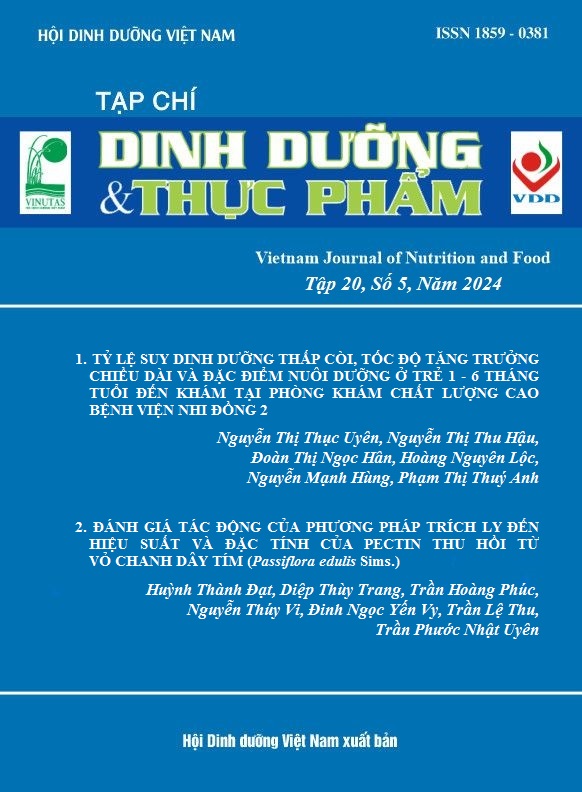KHẢO SÁT KHẢ NĂNG KHÁNG KHUẨN VÀ CHỐNG OXY HÓA CỦA CAO CHIẾT LÁ SẢ CHANH (Cymbopogon citratus)
Nội dung chính của bài viết
Tóm tắt
Mục tiêu: Nghiên cứu nhằm xác định thành phần các hoạt chất sinh học, khả năng kháng khuẩn và chống oxy hóa của cao chiết lá sả chanh (Cymbopogon citratus) trong nước, ethanol 96% và methanol 96%.
Phương pháp: Phương pháp định tính các hợp chất tự nhiên có trong cao chiết lá sả chanh dựa vào các phản ứng tạo màu. Khảo sát khả năng chống oxy hóa của cao chiết sử dụng phương pháp bắt gốc tự do diphenylpicrylhydrazyl (DPPH). Khảo sát khả năng kháng khuẩn được tiến hành theo phương pháp khuyếch tán giếng thạch.
Kết quả: Thành phần hoạt chất được tìm thấy trong cao chiết lá sả chanh bao gồm alkaloid, flavonoid, saponin, terpenoid, coumarin quinone và tannin. Dung môi methanol 96% cho hiệu quả tốt nhất trong chiết xuất lá sả chanh. Hoạt tính kháng khuẩn của cao chiết trên E.coli là 2,50±0,50 và hiệu suất chống oxy hóa cao nhất là 95,77% với giá trị IC50 là 298,40 μg/mL ở cao chiết lá sả chanh trong dung môi methnol 96%.
Kết luận: Cao chiết từ dung môi methanol 96% có khả năng chiết xuất hầu hết các hợp chất có trong lá sả chanh như: alkaloid, flavonoid, saponin, terpenoid, quinone, tannin. Tất cả 3 loại cao chiết lá sả chanh trong nước, ethanol 96%, methanol 96% điều có khả năng kháng khuẩn. Từ các kết quả trên cho thấy được lá sả chanh là một vật liệu tiềm năng cho các nghiên cứu về khả năng kháng khuẩn, chống oxy hóa và các nghiên cứu khác về hợp chất tự nhiên có hoạt chất sinh học.
Từ khóa
cao chiết, chống oxy hóa, kháng khuẩn, 𝘊𝘺𝘮𝘣𝘰𝘱𝘰𝘨𝘰𝘯 𝘤𝘪𝘵𝘳𝘢𝘵𝘶𝘴
Chi tiết bài viết
Tài liệu tham khảo
2. Milica A, Ivana Č, Mirjana C, et al. Cymbopogon citratus (DC.) Staph: Chemical composition, antimicrobial and antioxidant activities, use in medicinal and cosmetic purpose. J Agron Technol Eng Manag. 2019;2(6):344-360.
3. Sessou P, Farougou S, and Sohounhloué D. Major component and potential applications of plant essentials oils as natural food preservatives: a short review research results. Int J Biosci. 2012; 2(8):45-57.
4. Balakrishnan B, Paramasivam S, and Arulkumar A. Evaluation of the lemongrass plant (Cymbopogon citratus) extracted in different solvents for antioxidant and antibacterial activity against human pathogens. Asian Pacific Journal of Tropical Disease. 2014;4:S134-S139. doi: 10.1016/S2222-1808(14)60428-X.
5. Olaiya C, Ojebode M and Karigidi K. Antioxidant and Antibacterial Activities of the Essential Oils of Cymbopogon citratus and Citrus sinensis. European Journal of Medicinal Plants. 2016;16(1):1-10. doi: 10.9734/EJMP%2F2016%2F28176.
6. Boeira CP, Natiéli P, Déborah CBF, Marcela BS, Bruna NL, Rosane TH, Jamila dSA, Paulo CBC, Daniel dS, Erico MMF, Claudia SdR, Nelcindo NT. Phytochemical characterization and antimicrobial activity of Cymbopogon citratus extract for application as natural antioxidant in fresh sausage. Food Chemistry. 2020;319:126553. doi: 10.1016/j.foodchem.2020.126553.
7. Ewansiha JU, Garba SA, Mawak JD, Oyewole OA. Antimicrobial activity of Cymbopogon citratus (lemon grass) and its phytochemical properties. Frontiers in Science. 2012;2(6):214-220. doi:10.5923/j.fs.20120206.14.
8. Yadav RNS & Agarwala M. Phytochemical analysis of some medicinal plants. Journal of Phytology. 2011; 3(12):10-14.
9. Ruangpan L. Minimal inhibitory concentration (MIC) test and determination of antimicrobial resistant bacteria. Tigbauan, Iloilo, Philippines: Aquaculture Department, Southeast Asian Fisheries Development Center. 2004:31-55.
10. Molyneux P. The use of the stable free radical diphenylpicrylhydrazyl for estimating antioxidant activity. Songklanakarin J sci Technol. 2004;26(2): 211-219.
11. Çalişkan O and Polat AA. Phytochemical and antioxidant properties of selected fig (Ficus carica L.) accessions from the eastern Mediterranean region of Turkey. Scientia Horticulturae. 2011;128(4):473-478. doi: 10.1016/j.scienta.2011.02.023.
12. Kumar, S and Pandey AK. Chemistry and biological activities of flavonoids: an overview. The Scientific World Journal. 29:2013; 162750. Doi: 10.1155/2013/162750.
13. Soares MO, Rita CA, Pedro CP, Beatriz PPO, Ana FV. Angolan Cymbopogon citratus used for therapeutic benefits: Nutritional composition and influence of solvents in phytochemicals content and antioxidant activity of leaf extracts. Food and Chemical Toxicology. 2013;60:413-418. doi: 10.1016/j.fct.2013.07.064.
14. Senthil KR, Vinoth KS, Abdul LMKM, Uma KS, Sudhakar P. Antioxidant and anti-inflammatory activities of leaf extracts of Flacourtia jangomas (Lour.) Raeusch: An study in vitro. Advance Pharmaceutical Journal. 2018;3(6):169-176. doi: 10.31024/apj.2018.3.6.1.
15. Morah FN & Otuk ME. Antimicrobial and anthelmintic activity of elecusine indica. Acta Sci et Intellectus. 2015; 1: 28-32.
16. Kumar S, Narwal S, Kumar V, & Prakash O. [alpha]-glucosidase inhibitors from plants: A natural approach to treat diabetes. Pharmacognosy reviews. 2011; 5(9): 19 - 29.
17. Courts FL, & Williamson G. The occurrence, fate and biological activities of C-glycosyl flavonoids in the human diet. Crit Rev Food Sci Nutr. 2015; 55(10):1352-1367.
18. Pereira RP, Fachinetto R , Alessandro de SP, et al. Antioxidant effects of different extracts from Melissa officinalis, Matricaria recutita and Cymbopogon citratus. Neurochemical Research. 2009;34:973-983. doi: 10.1007/s11064-008-9861-z.
19. Rice-Evans C and Miller N. Measurement of the antioxidant status of dietary constituents, low density lipoproteins and plasma. Prostaglandins Leukot Essent Fatty Acids. 1997;57(4-5):499-505. doi: 10.1016/s0952-3278(97)90435-x.
20. Wiseman SA, Balentine DA and Frei B. Antioxidants in tea. Critical Reviews in Food Science & Nutrition. 1997;37(8):705-718. doi: 10.1080/10408399709527798.
21. Vinson JA,Yousef AD, Mo S, Jinhee J. Plant flavonoids, especially tea flavonols, are powerful antioxidants using an in vitro oxidation model for heart disease. Journal of Agricultural and Food Chemistry. 1995;43(11):2800-2802. doi:10.1021/jf00059a005.


